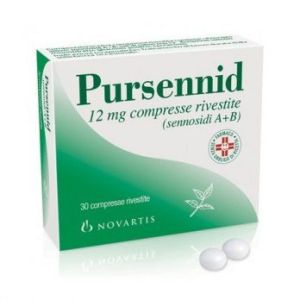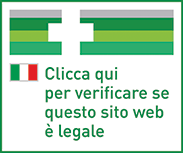Ship in Europe, Find out rates!

Pursennid 40 Compresse Rivestite 12 mg
NOVARTIS
Short-term treatment of occasional constipation.
WARNINGS
The established dose should not be exceeded. Prolonged indiscriminate use of laxatives can lead to addiction and deterioration of intestinal functions. The lowest effective dosage should be used to restore normal bowel function. If no improvement in the bowel has been achieved, the dose may be increased under medical supervision. Products containing senna and sennosides should only be used if a therapeutic effect cannot be obtained through a change in diet or the administration of bulking agents. The use of these drugs requires medical supervision: if there are no positive effects following the treatment; if use is prolonged beyond one week of treatment; if symptoms persist or worsen; after a laparotomy or abdominal surgery; if there are skin rashes, nausea and vomiting; in children between 10 and 12 years old; during pregnancy and breastfeeding. Lactose: Patients with rare hereditary problems of galactose intolerance, lactase deficiency, or glucose-galactose malabsorption should not take this medicine. Glucose: Patients with rare glucose-galactose malabsorption problems should not take this medicine. Sucrose: Patients with rare hereditary problems of fructose intolerance, glucose-galactose malabsorption, or sucrase-isomaltase insufficiency should not take this medicine.
PHARMACOTHERAPEUTIC CATEGORY
Stimulant laxatives.
STORAGE
This medicine does not require any special storage conditions.
CONTRAINDICATIONS / SECONDARY EFFECT
Hypersensitivity 'to the active substance or to any of the excipients. Contraindicated if the following medical conditions exist: inflammatory diseases of the digestive system (ie Crohn's disease, ulcerative colitis, liver disease, peritonitis and inflammatory bowel diseases). Irritation or obstruction of the gastrointestinal tract (ie spastic constipation, obstruction of the ileum / preileus, cramps and pains, nausea, vomiting and colic). Abdominal symptoms which may be due to an underlying undiagnosed condition, such as intestinal acute conditions which may require surgery (eg acute diverticulitis, appendicitis and massive diarrhea). States of severe dehydration, with loss of water and electrolytes, especially hypokalaemia. Contraindicated in children younger 'less than 10 years.
NAME
PURSENNID 12 MG COATED TABLETS
EXCIPIENTS
Lactose monohydrate; stearic acid; talc; cornstarch; anhydrous glucose; sucrose; Arabic gum; anhydrous colloidal silica; titanium dioxide, cetyl palmitate.
SIDE EFFECTS
This medicine can cause mild abdominal discomfort such as abdominal pain, cramps, irritation of the colonic and gastric mucosa. Other effects such as dehydration, hypotension, fatigue, myopathies, stomach pain, hyponatremia, renal disorders, secondary aldosteronism, hypocalcemia and hypomagnesaemia have also been reported. These adverse reactions are usually reversible once the laxative is stopped. Prolonged use or overdose of this drug can cause nausea, diarrhea with excessive loss of electrolytes, especially potassium (hypokalemia). There is also the possibility of developing megacolons. During treatment, a brownish-yellow (pH-dependent) discoloration of the urine due to metabolites may occur, which is of no clinical significance. Habituation has been reported after prolonged treatment. Frequencies are defined as: very common (> = 1/10), common (> = 1/100, <1/10); uncommon (> = 1 / 1,000, <1/100); rare (> = 1 / 10,000; <1 / 1,000); very rare (<1 / 10,000), or not known. Undesirable effects in post-marketing experience. Gastrointestinal disorders. Not known: megacolon, abdominal pain, diarrhea, nausea, abdominal discomfort. General disorders and administration site conditions. not known: fatigue, drug tolerance. Musculoskeletal and connective tissue disorders. Not known: myopathy. Renal and urinary pathologists. Not known: kidney problems; not known: chromaturia. Metabolism and nutrition disorders. Not known: hyperaldosteronism, hypocalcemia, hypomagnesaemia, dehydration, hypokalemia, hyponatremia, decreased blood electrolytes. Vascular pathologies. Not known: hypotension. The adverse events listed above are based on spontaneous and post-marketing reports and represent a less accurate estimate of the incidence that would be obtained in clinical trials. Pediatric population: The same frequency, type and severity of adverse events are expected in children and adults. Report any suspected adverse reactions via the national reporting system.
PREGNANCY AND BREASTFEEDING
There are no reports of side effects or harm during pregnancy and the fetus at the recommended dosage regimen. However, due to experimental data concerning the genotoxic risk of various anthraquinones, emodin and aloe-emodin, use during pregnancy is not recommended. Use during lactation is not recommended as there are insufficient data on the excretion of metabolites in breast milk. Small amounts of metabolites (reine) are excreted in breast milk. No laxative effects have been reported on breastfed infants. Preclinical studies with sennosides do not indicate particular risks for fertility at therapeutically relevant doses.
INDICATIONS
Short-term treatment of occasional constipation.
INTERACTIONS
The concomitant use of other drugs that induce hypokalaemia (iediuretics, adrenocorticosteroids and licorice) can 'increase the electrolyte imbalance. Hypokalemia (resulting from the abuse of laxatives taken for a long time) potentiates the action of cardiac glycosides and interferes with antiarrhythmic drugs, with other drugs that induce the return to sinus rhythm (quinidine) and with drugs that induce elongation of the QT interval.
DOSAGE
Adults and children over 12 years of age: 2-4 coated tablets per day. Children between 10 and 12 years: 1-2 coated tablets per day. After a short period of treatment without appreciable results, consult your doctor. The correct dose is the minimum sufficient to produce an easy evacuation of soft faeces. It is advisable to initially use the minimum doses provided. When necessary, the dose can then be increased, but without ever exceeding the maximum indicated. Contraindicated in children younger 'less than 10 years. Method of administration: take preferably in the evening. The action of Pursennid manifests itself after 6-12 hours. Administered in the evening, the effect of the drug appears the next morning. Laxatives should be used as infrequently as possible and for no more than seven days. Use for longer periods of time requires a doctor's prescription after adequate evaluation of the individual case. Ingest together with an adequate quantity of water (a large glass). A diet rich in liquids favors the effect of the medicine.
| Destination | Cost | Detail |
|---|---|---|
| Italy | €5,90* | 24/72H |
| Austria, France, Germany, Slovenia | € 13* | 3 days |
| Belgium, Luxembourg, Portugal, Netherlands, Spain | € 14* | 4 days |
| Bulgary, Cechia, Hungary, Poland, Romania, Slovakia | € 19* | 5 days |
| Denmark, Estonia, Finland, Ireland, Lithuania, Latvia ,Sweden | € 22* | 5 days |
| United Kingdom, Switzerland, Greece | € 30* | 7 days |
| Canada, USA | € 40 | 7 Days |
European shipments with express courier: FedEx, MBE, DHL
*For the shipment outside band B ther's an extra cost of 22€ *For the shipment outside band C ther's an extra cost of 30€ Delivery Times exclude Saturday and Holidays
For Islands and Areas of difficult Accessibility the shipments are made in 72 hours and the cost will be increased by 15€
